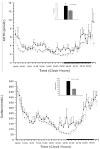CHRONIC INSOMNIA AND STRESS SYSTEM
- PMID: 18071579
- PMCID: PMC2128619
- DOI: 10.1016/j.jsmc.2007.04.002
CHRONIC INSOMNIA AND STRESS SYSTEM
Abstract
SynopsisIn insomnia, which is a very common sleep disorder, objective sleep measures, EEG activity, physiologic findings, HPA axis activity and inflammation markers suggest that it is not a state of sleep loss, but a disorder of hyperarousal present both during the night and the daytime. Several psychological and physiological factors contribute to the onset and perpetuation of insomnia, such as anxious-ruminative personality traits, stressful events, age-related sleep homeostasis weakening mechanisms, menopause and biologic - genetic diathesis of CNS hyperarousal. The therapeutic approach in insomnia should be multidimensional reducing the overall emotional and physiologic hyperarousal and its underlying factors present throughout the 24-h sleep/wake period.
Figures







References
-
- US Department of HEW . Selected symptoms of psychological distress. US Department of HEW; Rockville(MD): 1970.
-
- Karacan I, Thornby JI, Anch M, Holtzer CE, Warheit GJ, Schwab JJ, et al. Prevalence of sleep disturbances in a primarily urban Florida county. Arch Gen Psychiatry. 1976;10:239–44. - PubMed
-
- Bixler EO, Kales A, Soldatos CR, Kales JD, Healey S. Prevalence of sleep disorders in the Los Angeles metropolitan area. Am J Psychiatry. 136:1257–62. 10979. - PubMed
-
- Mellinger GD, Balter MB, Uhlenhuth EH. Insomnia and it's treatment. Prevalence and correlates. Arch Gen Psychiatry. 1985;42:225–32. - PubMed
-
- Klink M, Quan SF. Prevalence of reported sleep disturbances in a general adult population and their relationship to obstructive airways diseases. Chest. 1987;91:540–6. - PubMed
Grants and funding
LinkOut - more resources
Full Text Sources
Other Literature Sources

